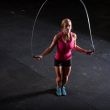Bodyflex is a set of special exercises aimed at stretching certain muscle groups and based on aerobic breathing (diaphragm). Burning fatty tissue occurs due to oxygenation of the blood with a deep breath. The tension of the given muscles of the body makes it possible to reduce fat deposits in the necessary areas, such as on the thighs, buttocks and the abdomen.
THE ESSENCE OF BODYFLEX
In its core, Bodyflex is an increased forced ventilation of the lungs (hyperventilation). Such exercises are performed by divers before diving into the water as they increase the duration of holding the breath.
The mechanism of respiratory gymnastics (Bodyflex) is as follows; inhale-exhale, then the stomach is drawn in and the breath is held, then a stretching position is taken for 10 counts and an inhalation is taken with maximum relaxation of the muscles at the end. Thus, Bodyflex maintains the body in a perfect shape without any additional exhausting exercises.
The respiratory system, which is the basis of Bodyflex exercises, performs a double function; it significantly increases the permeability of oxygen particles to all areas, organs, tissues of the body and contributes to the complete relaxation of the body. Usually, most people breathe shallowly. And this is not beneficial, because shallow breathing leads to poor oxygen supply and as a result, it can provoke many health problems of a very different nature.
The essence of Bodyflex boils down to learning deep breathing, thereby expanding the arteries and pre-preparing cells for the best assimilation of oxygen. That is why Bodyflex (breathing exercises + a set of stretching exercises) helps to solve problems that are associated with poor well-being and health.
Basically, Bodyflex is recommended for:
• Formation of concentration, mobilization and maintenance of readiness for action (for example, in the most stressful periods of life, like exams and other stressful situations);
• Creating a necessary image before an important event, when there is a need to feel great and look especially attractive or “fit”;
• Quick recovery and an instant rest;
• Normalization of the body, restoration of the original weight.
HOW TO DO BODYFLEX
First of all, the principle of body flexing consists of mastering the technique of diaphragmatic (deep aerobic) breathing. Physical-isotonic exercises (they are focused on muscle contraction and relatively active amplitude movements of the joints) and isometric exercises (they are based on the static effect of muscle tissue contraction) are performed together with the respiratory complex.
Bodyflex breathing exercises consist of 5 stages:
1. Complete release of air from the lungs – maximum exhalation, in which the lips must be folded “into a tube” and make a uniform, calm and slow exhalation through the mouth until the maximum release of air is felt;
2. A sharp breath through the nose – produced powerfully and strongly without opening the mouth and with loud noise effects, air should enter as much as possibl, after inhalation, they hold the air inside, blocking the nose and mouth;
3. Rapid exhalation through the mouth (diaphragmatic) – with the tension of the abdominal muscles and a powerful push of the air mass from the inside through the wide open mouth, accompanied by a hissing sound coming from the diaphragm, not from the throat;
4. Retraction of the abdomen – combined with holding the breath and tilting the head to the chest, as the abdominal muscles “pull” inward to 8 counts, the stomach and nearby organs are also pulled to the hypochondrium zone, which should give rise to a feeling as if the stomach is going up, pulling the intestines along with it and as a result, they should, as it were, stick to the spinal column;
5. Inhalation through the nose and relaxation – the release of muscle tension in the abdomen is accompanied by inhalation through the nose, at which point characteristic sounds should appear, as if sobbing.
THE BENEFITS OF BODYFLEX
Some experts recognize Bodyflex as one of the best and most advanced ways to enrich tissues with oxygen. As a result, disease-causing bacteria, dangerous viruses and even cancer cells are destroyed.
In addition, Bodyflex allows you to achieve an aerobic effect 5 times faster than running. For example, in 1 hour of jogging, about 700 kcal is burned, while from the same period of Bodyflex exercises, the body loses up to 3,500 kcal. At the same time, there is absolutely no feeling of hunger, as with any other physical activity.
Aerobic breathing “massages” the internal organs well, normalizes the lymph flow, which together improves metabolism and leads to an excellent well-being.
With the constant practice of Bodyflex, the body accumulates more energy, as it reduces the fat amount, muscles become stronger and breathing deepens. The developers of the method promise that in 1 week of training, you can reduce the volume of the body in the abdomen within 10 cm to 30 cm with just 15 minutes of exercise per day.
Bodyflex strengthens the immune system, heals blood vessels and the heart, normalizes the functionality of the stomach and intestines, improves well-being and solves many health problems. It gives the body energy, provides vigour, activates the work of internal systems and organs, produces a rejuvenating effect, strengthens the spinal column, corrects body and figure proportions, stimulates metabolic processes, fat burning and promotes the elimination of toxins.
BODYFLEX CRITIC
Other specialists, on the contrary, find body flex harmful, since it is based on oxygen starvation and breath holding and this, in general, is risky for the body and brain. Their argument is as follows; the danger to the brain is that a person begins to perceive the environment worse and think poorly, up to the emergence of inadequacy and the danger to the body lies in the fact that oxygen starvation can provoke the development of cancerous tumours within the tissues.
In addition, hyperventilation of the lungs is more likely not an accumulation of oxygen, but the removal of increased volumes of carbon dioxide from the body. Therefore, prolonged hyperventilation can give such an effect as loss of consciousness and involuntary temporary cessation of breathing and apnoea as a result of blood depletion of carbon dioxide.
Blood flow in the brain also changes dramatically. Even increased ventilation of the lungs for a short time leads to constriction of the blood vessels in the brain, due to which blood supply is reduced by 35 percent. The optimal time for hyperventilation, according to doctors, should not exceed 1 minute. Hyperventilation over 60 seconds can lead to muscle cramps.
In connection with the above, Bodyflex has certain limitations, as it cannot be put into practice for people with a problematic thyroid gland, high blood pressure and for those who have suffered with traumatic brain injuries of any type.




